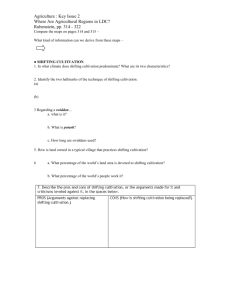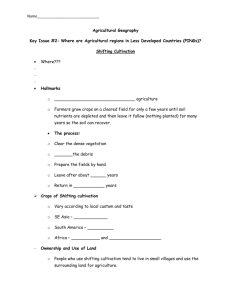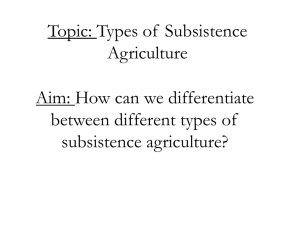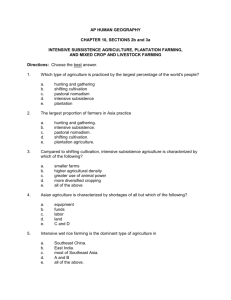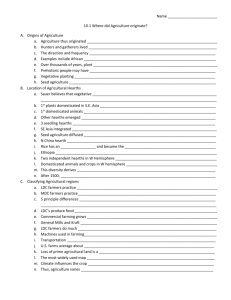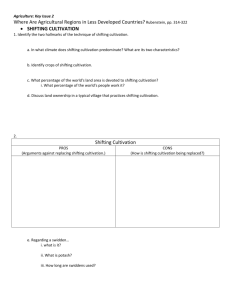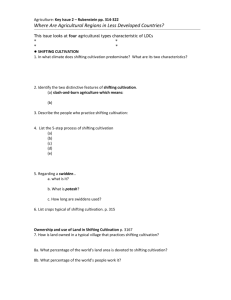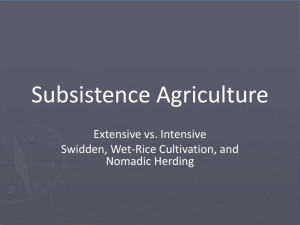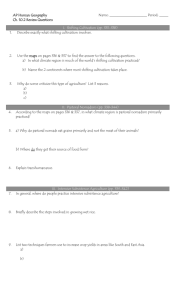Human Geography
advertisement
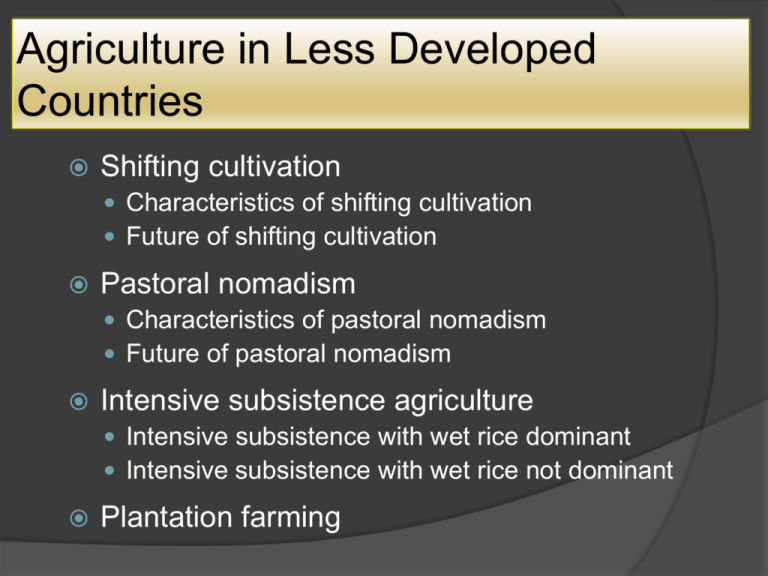
Agriculture in Less Developed Countries Shifting cultivation Characteristics of shifting cultivation Future of shifting cultivation Pastoral nomadism Characteristics of pastoral nomadism Future of pastoral nomadism Intensive subsistence agriculture Intensive subsistence with wet rice dominant Intensive subsistence with wet rice not dominant Plantation farming World Climate Regions Fig. 10-5a: Simplified map of the main world climate regions (see also Fig. 2-2). World Agriculture Regions Fig. 10-5b: Locations of the major types of subsistence and commercial agriculture. Shifting Cultivation What is shifting cultivation? A form of subsistence agriculture in which people shift activity from one field to another; each field is used for crops for a relatively few years and left fallow for a relatively long period. Why do you think we call it shifting cultivation as opposed to agriculture? When you use the term agriculture it is usually referenced to using greater tools and animals and a more sophisticated modification of the landscape. Shifting Cultivation continued… What are the two hallmarks? Slash and burn agriculture Growing crops on a cleared field until soil nutrients are depleted. They then leave it fallow so the soil can recover. What crops are grown? *Vary by local custom and taste. The predominant crops include…… Southeast Asia: Rice South America: Corn and Cassava Africa: millet and sorghum Others include: yams, sugarcane, plantain, and vegetables Shifting Cultivation in Guatemala Dense vegetation has been cut and is being burned to open land for farming. Land Clearing in Colombia Bulldozers are used to plow a road through the rain forest in Colombia. Pastoral Nomadism What is pastoral nomadism? A form of subsistence agriculture based on herding domesticated animals. What do the animals provide? -milk, and their skins and hair are used for clothing and tents Important to know: • Pastoral nomads consume mostly grain rather than meat • Animals are commonly not slaughtered, although dead ones may be consumed • The size of their heard is both important measure of power and prestige and their main security during adverse environmental conditions. Pastoral nomadism continued… Choice of animals include: Camel Sheep and Goats Horse Important: *The typical nomadic family needs 25 to 60 goats or sheep or 10 to 25 camels. Pastoral Nomads in Iran Qashqai nomads using paved roads to move their animals near Shiraz, Iran. Intensive Subsistence Agriculture What is it? A form of subsistence agriculture in which farmers must expend a relatively large amount of effort to produce the maximum feasible yield from a parcel of land. (Basically, the farmers must work more intensively to subsist on a parcel of land) Important: ¾’s of worlds people live in LDC’s and this is the system used Intensive Subsistence with wet rice dominant Wet rice? Wet rice refers to the practice of planting rice on dry land in a nursery and then moving the seedlings to a flooded field to promote growth. Occupies a small percentage of Asia’s agricultural land, but it’s the regions most important source of food. What does it mean to be dominant? - simply, this means it is the dominant type of agriculture in Southeast China, East India, and much of Southeast Asia. Intensive Subsistence with Wet Rice Not Dominant What is meant by wet rice not dominant? More than one harvest can be obtained some years through skilled use of crop rotation World Rice Production, 2005 Fig. 10-6: Asian farmers grow over 90% of the world’s rice. India and China alone account for over half of world rice production. Wet Rice Terraces in Indonesia Terraces create flat land for wet (irrigated) rice on hilly land in Indonesia. Rice Harvesting, Indonesia Wet rice is often harvested by hand in Asia.
